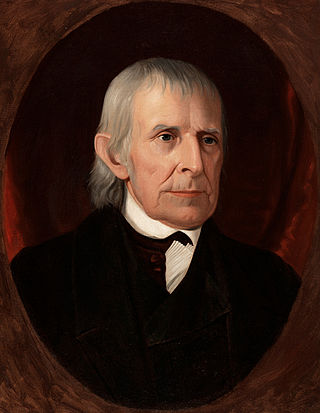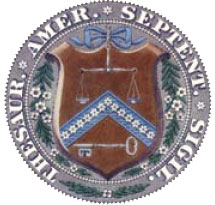
The two-cent piece was produced by the Mint of the United States for circulation from 1864 to 1872 and for collectors in 1873. Designed by James B. Longacre, there were decreasing mintages each year, as other minor coins such as the nickel proved more popular. It was abolished by the Mint Act of 1873.

The American Numismatic Association (ANA) is an organization founded in 1891 by George Francis Heath. Located in Colorado Springs, Colorado, it was formed to advance the knowledge of numismatics along educational, historical, and scientific lines, as well as to enhance interest in the hobby.

The Franklin half dollar is a coin that was struck by the United States Mint from 1948 to 1963. The fifty-cent piece pictures Founding Father Benjamin Franklin on the obverse and the Liberty Bell on the reverse. A small eagle was placed to the right of the bell to fulfill the legal requirement that half dollars depict the figure of an eagle. Produced in 90 percent silver with a reeded edge, the coin was struck at the Philadelphia, Denver, and San Francisco mints.

Charles Edward Barber was an American coin engraver who served as the sixth chief engraver of the United States Mint from 1879 until his death in 1917. He had a long and fruitful career in coinage, designing most of the coins produced at the mint during his time as chief engraver. He did full coin designs, and he designed about 30 medals in his lifetime. The Barber coinage were named after him. In addition, Barber designed a number of commemorative coins, some in partnership with assistant engraver George T. Morgan. For the popular Columbian half dollar, and the Panama-Pacific half dollar and quarter eagle, Barber designed the obverse and Morgan the reverse. Barber also designed the 1883 coins for the Kingdom of Hawaii, and also Cuban coinage of 1915. Barber's design on the Cuba 5 centavo coin remained in use until 1961.

The American twenty-cent piece is a coin struck from 1875 to 1878, but only for collectors in the final two years. Proposed by Nevada Senator John P. Jones, it proved a failure due to confusion with the quarter, to which it was close in both size and value.

The United States large cent was a coin with a face value of 1/100 of a United States dollar. Its nominal diameter was 11⁄8 inch (28.57 mm). The first official mintage of the large cent was in 1793, and its production continued until 1857, when it was officially replaced by the modern-size one-cent coin.
The Rochester Numismatic Association (RNA) is a not-for-profit organization with an educational mission. The RNA was organized in 1912 by a group of local collectors to attract the American Numismatic Association's annual convention to Rochester, New York, USA. They met with success as the ANA did hold their convention in Rochester. The RNA has met continuously since 1912. Only one local coin club, the Boston Numismatic Society, founded in 1860, has a longer record of continuous meetings.
Jerome "Jerry" Hosmer Remick III was a Canadian numismatist, geologist and columnist for Canadian Coin News.

Joseph Farran Zerbe was an American coin collector and dealer who was the president of the American Numismatic Association (ANA) in 1908 and 1909. He served as chief numismatist at the World's Fairs in St. Louis (1904), Portland (1905), and San Francisco (1915).
Alex Shagin is a coin designer.
Alphonse Anton Kolb (1893–1983) was a German-American artist known for creating sculptures and other art works ranging in size from medals to statues. For many years he worked for Bastian Brothers of Rochester, New York, and was the semi-official sculptor of the Rochester Numismatic Association.
Donald Nelson Everhart II is an American coin and medal engraver-medalist, and sculptor who has worked for the private Franklin Mint, as a freelance designer, and since 2004 has worked for the United States Mint in Philadelphia. With over 1,000 models for coins and medals attributed to him as of 2008, he is still at the prime of his career creating the bas-relief models for these and similar sculptural objects. His coin designs are in the pockets of American citizens, and despite his late arrival to the series of the popular U.S. Statehood Quarters, he has designed and modeled three State's unique reverse designs, modeled three others, and six U.S. commemorative coins. His portrait of President William Clinton was chosen for Clinton's second term Inaugural Medal. Among his other medal creations are six Congressional Gold Medals for the U.S. Mint, seven Society of Medalists issues, twelve calendar medals, and other models for private medal makers, as well as cast art medals.

John Adam Eckfeldt was a worker and official during the first years of the United States Mint. A lifelong Philadelphian, Eckfeldt served as the second chief coiner of the Mint, from 1814 until 1839.

The United States Assay Commission was an agency of the United States government from 1792 to 1980. Its function was to supervise the annual testing of the gold, silver, and base metal coins produced by the United States Mint to ensure that they met specifications. Although some members were designated by statute, for the most part the commission, which was freshly appointed each year, consisted of prominent Americans, including numismatists. Appointment to the Assay Commission was eagerly sought after, in part because commissioners received a commemorative medal. These medals, different each year, are extremely rare, with the exception of the 1977 issue, which was sold to the general public.

The Lynchburg Sesquicentennial half dollar was a commemorative half dollar designed by Charles Keck and struck by the United States Bureau of the Mint in 1936, to celebrate the 150th anniversary of the 1786 incorporation of the independent city of Lynchburg, Virginia. The obverse of the coin depicts former Secretary of the Treasury and U.S. Senator Carter Glass, a native of Lynchburg. The reverse depicts a statue of the Goddess of Liberty, with Lynchburg sites behind her, including the Old Courthouse and the city's Confederate monument.
A numismatist is a specialist, researcher, and/or well-informed collector of numismatics/coins. Numismatists can include collectors, specialist dealers, and scholar-researchers who use coins in object-based research. Although use of the term numismatics was first recorded in English in 1799, people had been collecting and studying coins long before then all over the world.

The Roosevelt dime is the current dime, or ten-cent piece, of the United States. Struck by the United States Mint continuously since 1946, it displays President Franklin D. Roosevelt on the obverse and was authorized soon after his death in 1945.

The Vexator Canadiensis tokens are thought to be politically satirical tokens produced in either Quebec City or Montreal sometime in the 1830s. The tokens present a very crude image of a vaguely male bust on their obverse, and a female figure on the reverse. The legends on either side were deliberately designed so that they are hard to definitively read, but are commonly known as the "vexators" based on a common interpretation of its obverse legend. Depending on the interpretation of the inscriptions, they can either be taken as a form of satirical protest against either an unpopular Upper Canada governor, or William IV as a "tormentor of Canada", or more simply, depicting a fur trapper. Since all of these interpretations are possible, the ambiguity would allow the issuer from escaping being cited for sedition.












